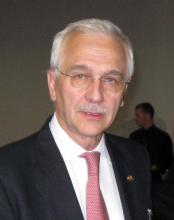The DynamX Bioadaptor – arguably the most original concept in coronary stent design to come along in 3 decades – demonstrated excellent safety and efficacy in a 12-month international, proof-of-concept study, Stefan Verheye, MD, said at the virtual annual meeting of the European Association of Percutaneous Cardiovascular Interventions.
“There has been no fundamental change in stent design in over 30 years,” declared Dr. Verheye, codirector of the Antwerp (Belgium) Cardiovascular Center. “The DynamX Bioadaptor is a fundamental innovation in device design.”
The investigational device is a 71-mcm-thick, cobalt-chromium metal platform that elutes novolimus from a biodegradable polymer. Circumferential rings in low-stress sections of the device are held together by polymer connectors, and when the polymer erodes at about 6 months the stent segments are able to disengage from each other while maintaining longitudinal continuity. Dr. Verheye called this process “uncaging” the stented artery. The result is restoration of normal vessel angulation and compliance; the artery is no longer artificially straightened and constrained by a relatively stiff stent. Positive adaptive remodeling is preserved with enhanced vessel pulsatility and maintenance of lumenal area for good blood flow.
Dr. Verheye said the impetus for developing this outside-the-box novel stent platform lies in the recognition of a major unmet need for better drug-eluting stent (DES) performance. “Despite excellent acute outcomes, data with current-generation DES show long-term event rates are high and accrue at a rate of 2%-3% per year without a plateau.”
He was coprincipal investigator for the international study, which included 50 patients who received a DynamX Bioadaptor for a single de novo coronary artery lesion no more than 24 mm in length. The acute performance of the device was similar to that of second-generation DES, with a mean acute gain post procedure of 1.63 mm by quantitative coronary angiography and a mean late lumen loss of 0.12 mm when measured again at 9 or 12 months.
Intravascular ultrasound imaging showed a 3% increase in mean target vessel area and a 5% increase in the stented area from post procedure to 9 or 12 months’ follow-up, with no change in mean lumen area, all of which translates into maintenance of good blood flow over time. In contrast, what typically occurs following implantation of current DES is maintenance of target vessel and device areas, but with a loss in mean lumen area, the cardiologist noted.
There were two cardiac deaths but no cases of target lesion revascularization, device thrombosis, or strut fracture within 12 months of the procedure.
“The Bioadaptor performs similarly to second-generation DES in terms of implantation technique, deliverability, conformability, and radial strength during the healing phase, while showing the promise of mitigating the 2%-3% annualized event rate beyond 1 year,” Dr. Verheye concluded, adding, “Obviously, longer-term follow-up in comparative studies will be needed to show a reduction in the device-oriented events that have been observed with current DES.”
Session cochair Davide Capodanno, MD, PhD, of the University of Catania (Italy), declared: “This is an intriguing device because it’s metal, but it’s a kind of pulsatile metal after the biodegradation of the connectors. It’s something I’ve never seen.”
Discussant William Wijns, MD, PhD, said he was “thrilled” by the innovative aspect of the DynamX Bioadaptor, but he’s a long way from being persuaded that the device’s potential physiological advantages will translate into improved clinical outcomes relative to current DES.
“Don’t we all have a strange feeling of deja vu because all these anticipated benefits are the same as those we were told we would see with fully bioresorbable scaffolds? And we know so much after 10 years of experience with bioresorbable scaffolds that probably we will not accept this great story unless we get more and more evidence,” cautioned Dr. Wijns, professor of interventional cardiology at the National University of Ireland, Galway, and chairman of EuroPCR.
The claim regarding bioresorbable scaffolds was that, even though the acute results weren’t as good as with DES, that disadvantage would be outweighed by superior long-term clinical outcomes. But in fact the long-term outcomes turned out to be worse as well.
“We had to give up immediate results with the bioresorbable scaffolds. I don’t think we want to go that route again this time,” the cardiologist said.
Thus, the first thing that’s needed in order to make a convincing case for the Bioadaptor is evidence from a large, randomized, comparative trial demonstrating that the acute performance of the novel device is noninferior to that of current DES, including data on complex lesions. Such a study was supposed to be underway now but has been delayed by the COVID-19 pandemic, he noted.
Once there is evidence that the acute results with the Bioadaptor are truly comparable with those achieved with current DES, there will be a need for long-term data showing that the device reduces the 2%-3% annualized event rate seen with DES beyond 1 year, Dr. Wijns added.
Dr. Verheye reported receiving consultation fees from study sponsor Elixir Medical as well as from Biotronik. Dr. Wijns reported receiving research grants from MicroPort.


